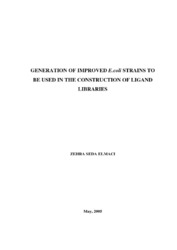Please use this identifier to cite or link to this item:
https://hdl.handle.net/11147/3198Full metadata record
| DC Field | Value | Language |
|---|---|---|
| dc.contributor.advisor | Arslanoğlu, Alper | - |
| dc.contributor.author | Elmacı, Zehra Seda | - |
| dc.date.accessioned | 2014-07-22T13:51:03Z | - |
| dc.date.available | 2014-07-22T13:51:03Z | - |
| dc.date.issued | 2005 | - |
| dc.identifier.uri | http://hdl.handle.net/11147/3198 | - |
| dc.description | Thesis (Master)--Izmir Institute of Technology, Biotechnology, Izmir, 2005 | en_US |
| dc.description | Includes bibliographical references (leaves: 56) | en_US |
| dc.description | Text in English; Abstract: Turkish and English | en_US |
| dc.description | xiv, 75 leaves | en_US |
| dc.description.abstract | The first step in the construction of ligand libraries is the total cloning of gene fragments coding millions of ligand variants into selected plasmid vectors. Since ligand proteins are expressed in fusion with the phage pIII protein, they can be incorporated into the newly synthesized phage particles in bacteria. The other proteins that make up the phage particle are supplied by the super infection of bacteria containing the ligand DNA clones with the helper phage. The diversity of the ligand libraries is directly proportional to the number of different gene fragments. In the current phage display technology, there are some drawbacks which can dramatically influence the diversity of a given ligand library. One of the drawbacks arises from the fact that, theoretically half of the phage particles, which are produced after super-infection, can carry only the helper phage genome instead of the ligand gene, even though they display a specific ligand protein. These phages can compete with those which carry both the ligand gene and its protein during the selection process and consequently they loose the ligand protein during the second round of selection. In any given library, this problem can cause the loss of rare but functionally very important ligands during the sequential selection procedure. Another drawback is the reinfection of a super-infected bacteria during or after the super-infection. This can increase the frequency of those phage particles which only carry the helper-phage genome, in the total phage population.These two disadvantages in the phage display technology are due to super-infection.This study aimed at the elimination of the super-infection step from the phage display technology by the insertion of M13 phage genome excluding intergenic region which contains the DNA sequences necessary for replication instead of uses of helper phage.To accomplish this purpose, Homologous Recombination method was used. It is an in vivo method for the replacement, deletion or insertion of sequences in bacteria.After Homologous Recombination, three colonies were observed and observed colonies were exposed some confirmation tests. First step of these tests was related to the presence of unique recombination cassette sequences in chromosomal DNA.Results we obtained showed that the presence of such fragments in chromosomal DNA. However, the functional test of the M13 genes in E.coli chromosome suggested the toxicity of an unidentified M13 gene products on E.coli chromosome. | en_US |
| dc.language.iso | en | en_US |
| dc.publisher | Izmir Institute of Technology | en_US |
| dc.rights | info:eu-repo/semantics/openAccess | en_US |
| dc.subject | Phage display technology | en_US |
| dc.subject.lcc | QR342 .E48 2005 | en |
| dc.subject.lcsh | Bacteriophages | en |
| dc.subject.lcsh | Ligands | en |
| dc.title | Generation of Improved E.coli Strains To Be Used in the Construction of Ligand Libraries | en_US |
| dc.type | Master Thesis | en_US |
| dc.institutionauthor | Elmacı, Zehra Seda | - |
| dc.department | Thesis (Master)--İzmir Institute of Technology, Bioengineering | en_US |
| dc.relation.publicationcategory | Tez | en_US |
| dc.identifier.wosquality | N/A | - |
| dc.identifier.scopusquality | N/A | - |
| item.openairetype | Master Thesis | - |
| item.cerifentitytype | Publications | - |
| item.grantfulltext | open | - |
| item.fulltext | With Fulltext | - |
| item.openairecristype | http://purl.org/coar/resource_type/c_18cf | - |
| item.languageiso639-1 | en | - |
| Appears in Collections: | Master Degree / Yüksek Lisans Tezleri | |
Files in This Item:
| File | Description | Size | Format | |
|---|---|---|---|---|
| T000320.pdf | MasterThesis | 7.14 MB | Adobe PDF |  View/Open |
CORE Recommender
Page view(s)
300
checked on Apr 7, 2025
Download(s)
86
checked on Apr 7, 2025
Google ScholarTM
Check
Items in GCRIS Repository are protected by copyright, with all rights reserved, unless otherwise indicated.